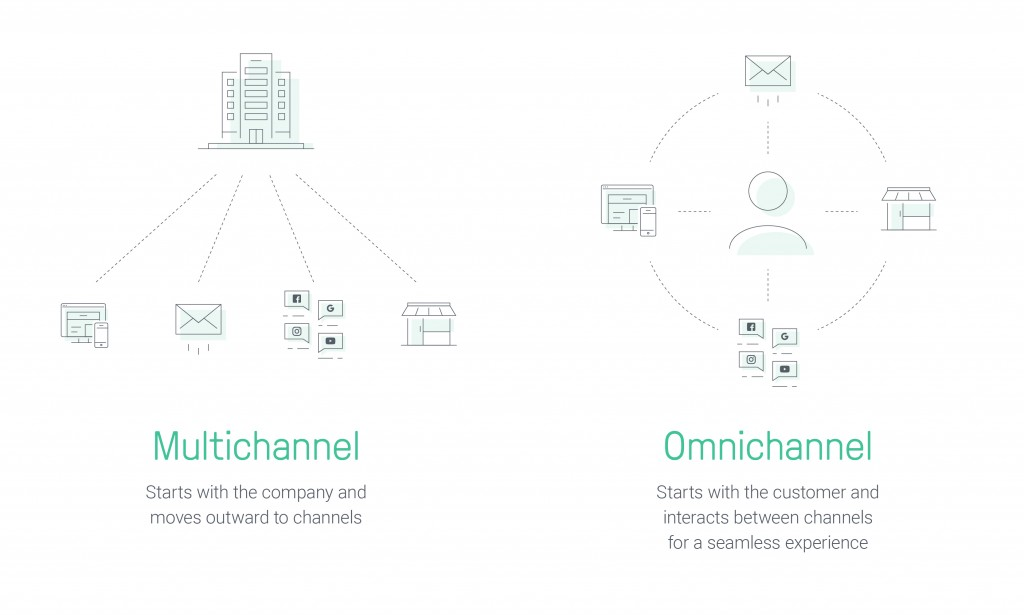Nowadays many shoppers don’t even remember how they learned about an eCommerce brand in the first place. If you ask them, the most popular answer is “I found it somewhere on the Internet”. Commercial information is all over the place, so nobody cares about the “channel” they use to find it anymore.
What they really care about is a smooth and seamless customer experience, from the very beginning of getting acquainted with the brand. In fact, 86% of today’s shoppers are willing to pay up to 25% more for goods just for a superior shopping experience.
Therefore, today’s challenge for entrepreneurs is to have as many quality touch points with their customers as possible. And make sure that their presence is bold, relevant, and uninterrupted.
Does that sound utopic?
A good marketing strategy can help you achieve that goal. The following best practices will guide you to deliver an effective omnichannel presence and leading customer experience.
What Is Omnichannel Marketing?
First of all, let’s determine what omnichannel marketing actually is, so we can all be on the same page.
Omnichannel marketing means that all your marketing channels are synchronized. They work together to provide customers with a seamless communication flow.
With a decent omnichannel marketing tool, you can reach your customers via email, Facebook Messenger or other messaging apps, Google retargeting, text messaging (SMS) and more, from one centralized platform. You can send them coordinated messages tailored to their behavior and make them feel that you know what they really need.
Usually, when we talk about communication via multiple channels, multichannel marketing is mentioned – but that is not the same thing as omnichannel.
Omnichannel Marketing vs. Multichannel Marketing
The multichannel marketing approach is like throwing a net into the ocean – you send the same message to a plethora of channels and audiences, hoping someone will see it and react.
Even if a shopper responds to one of your messages, do the other channels automatically change their messages to match the shopper’s action?
Multichannel marketing is fine at the very beginning of your business, when you focus on customer acquisition and sales. Later, however, it becomes completely worthless for growing customer retention and business sustainability.
Meanwhile, an omnichannel marketing strategy brings a totally different approach to customer engagement.
Instead of dividing resources and energy among multiple channels, the omnichannel strategy is hosted on one comprehensive platform from which you coordinate the entire brand communication.

Here you can set up the communication flows according to different customer behaviors on different channels. The messages adjust to customers’ actions and bring them an uninterrupted customer experience.
Big players like Amazon or AliExpress have been implementing their omnichannel marketing strategies for a long time now, and their results speak for themselves.
If you feel that it’s time to raise your eCommerce business to the next level, here are some of the best omnichannel marketing practices.
#1. Audit the Overall Customer Experience Your Business Offers
Before starting something new, you have to revise what you already have and how it works.
Auditing is probably not the most entertaining part of the work, but it’s vital if you want to know which channels are the most effective for your business. So what should you revise in particular?
- All the possible ways through which visitors get to your store: try to find your goods in web search results, on social media, blog reviews, etc., and check your analytics to see if the stats match with what you found;
- Complete a real order in your store. Is there anything in the process that raises any red flags?
- Go through your own returns and refunds process. Is it easy and straightforward?
- Submit support tickets and evaluate the customer experience.
- Read reviews of your services and products.
Ask yourself what you can improve so your shoppers would have an even better experience with your brand.
Also, you should ask for customer feedback when implementing an omnichannel marketing strategy. This is something you will have to do on a regular basis, so you need to find a way to automate it.
The easiest way is to ask customers to review their purchase and the product they bought in the automated post-purchase email you send them. You can ask for an evaluation when they contact your support team, as well.
By listening to and acting on customer feedback, you can make sure that your customers are always happy and learn how you can improve the overall experience they have with your brand.
#2. Segment Your Audience
The times of sending indiscriminate bulk promotional messages are long gone.
Each customer has different goals, desires, and concerns. By spamming them with the same “one-size-fits-all” message, not only are you doing yourself a disservice, but you’re also disrespecting your customers.
Sending non-personalized mass messages tells them that you don’t really care about what they need. People won’t respond if the message isn’t relevant to them.
Knowing your customers and segmenting them by as much granular data as possible enables you to delight them with highly targeted messages that speak to their wants.
Here are a few ways in which you might try to segment your audience:
- By previous shopping behavior in your store: past/ recent purchases;
- By profile data: demographic information about your customers;
- By campaign activity: how a customer has reacted to your recent marketing campaigns (interactions, conversions, etc.).
If you know what the customer has bought from you recently and how much money they have spent in your store, you can personalize cross-selling and up-selling offers. If they haven’t bought anything in a while, send them an appealing reactivation email.
Segmentation by customers’ profile data also enables you to send them personalized offers. For example, an ad-hoc sale of warm winter jackets for customers living in Chicago, when the snowstorm hit.
It’s also a good idea to serve customized messages to your audiences according to the interactions they have had with your previous campaigns. For instance, you can A/B test different subject lines for the same campaign with those that haven’t opened previous emails. You can also identify and then try to reactivate inactive shoppers with groundbreaking deals.
The more data you have about your customers, the more precise segments you can create. All statistics show that highly targeted messages with attached relevant incentives always bring high conversion rates.
#3. Start Your Omnichannel Marketing Strategy with Three Channels
By providing customers with a superior brand experience, omnichannel marketing boosts customer retention rates too.
One study has shown that “companies with an extremely strong omnichannel customer engagement have an 89% customer retention rate, compared to 33% for companies with weak engagement”.
At Omnisend, we have found similar results – marketers who used at least three channels in their marketing automation workflows gained an approximately 90% customer retention rate. The most common combination: Facebook retargeting, automated emails and SMS.
We also discovered that when eCommerce marketers used three or more channels in their omnichannel communication, their campaigns outperformed single-channel campaigns in engagement and purchase rates by over 250%.
That is because single-channel customers don’t exist anymore. It would be great if someone just came across your site from Google and purchased on their first visit. While it does happen from time to time, it’s rare.
A customer needs 6-7 touchpoints with a brand before they feel comfortable enough to purchase. By limiting your marketing automation to one channel, you’re reducing the number of potentially available touchpoints and ultimately leaving money on the table.
That’s quite a good reason to create an omnichannel marketing strategy for your eCommerce store.
#4. Always Measure Everything You Do
An omnichannel strategy requires regular evaluation and upkeep.
The best time to send promotional text messages, the best times to ask for reviews, what incentives work best and so on –you will only get these insights by regularly and frequently assessing the implementation of your marketing strategy.
By looking closely at the results of your commercial campaigns and at customer behavior, you will then understand where and how to adjust and improve your messaging. Then you repeat the execution – evaluation – adjustment cycle.
You need to measure the impact of everything:
- Your message
- Your copy
- Your images
- Your segments/targeting
- Your timing.
There are many things you can and should be testing as you implement this strategy. Marketing is not static, we need to keep up with customers’ attitudes that are changing faster than any technology on the market right now.
The only way to do that is to keep testing and finding the best ways of doing things for your customers.
If you want to be more visible on multiple channels, provide customers with a great brand experience, increase customer retention and do it all from one place, an omnichannel marketing strategy is exactly what you are looking for.
At the end of the day, your customer is the center of your business, because you can’t survive without them. By focusing your channels and strategy around what customers want and need, you can’t go wrong.
However, such a strategy isn’t something that you can build in a day. It takes consistent focus on implementation, measurement and constant adjustment. But with an omnichannel approach, you will be able to provide a customer experience that will grow your conversion rates and generate the customer loyalty your business needs to evolve.
About the author
Karolina Petraškienė is a blogger and email enthusiast at Omnisend, the ecommerce marketing automation platform dedicated to helping ecommerce stores build strong, lasting relationships with their customers.






